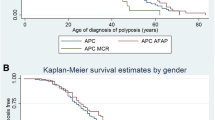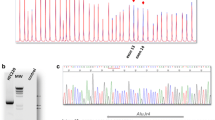Abstract
Objective
Group IVA cytosolic phospholipase A2 (cPLA2α) plays a key role in tumorigenesis via generating arachidonic acids as the substrate of cyclooxygenase. The aim of this study was to elucidate the possible associations between cPLA 2 α gene polymorphisms and phenotypic features of patients with familial adenomatous polyposis (FAP).
Patients and Methods
A tag single nucleotide polymorphisms (SNPs)-based genotype–phenotype association study of the cPLA 2 α gene was conducted in 73 Japanese patients from 59 families with FAP. Based on the HapMap database, seven tag SNPs of the cPLA 2 α gene were selected and genotyped by direct sequencing analysis. The genotype–phenotype association in relation to the adenomatous polyposis coli (APC) gene mutation was also assessed.
Results
The single SNP analysis showed that rs3820185 C allele [odds ratio (OR), 2.5; 95% confidence interval (CI), 1.2–4.9] and rs127446200 GG genotype (OR, 10.9; 95%CI, 1.6–69.8), were more frequent in patients with gastric fundic gland polyposis (FGP) than in those without. Rs12749354 C allele was more frequently found in patients with small intestinal adenoma (OR, 7.0; 95% CI, 1.5–30.4; p = 0.008). This association was also significant when adjusted for covariates (age, sex, and APC mutation) in a logistic regression analysis (adjusted OR, 7.4; 95% CI, 1.2–64.2; p = 0.027).
Conclusions
The cPLA 2 α gene may be a possible disease modifier gene in FAP.

Similar content being viewed by others
References
Nishisho I, Nakamura Y, Miyoshi Y et al (1991) Mutations of chromosome 5q21 genes in FAP and colorectal cancer patients. Science 253:665–669
Spirio L, Otterud B, Stauffer D et al (1992) Linkage of a variant or attenuated form of adenomatous polyposis coli to the adenomatous polyposis coli (APC) locus. Am J Hum Genet 51:92–100
Galiatsatos P, Foulkes WD (2006) Familial adenomatous polyposis. Am J Gastroenterol 101:385–398
Nugent KP, Phillips RK, Hodgson SV et al (1994) Phenotypic expression in familial adenomatous polyposis: partial prediction by mutation analysis. Gut 35:1622–1623
Davies DR, Armstrong JG, Thakker N et al (1995) Severe Gardner syndrome in families with mutations restricted to a specific region of the APC gene. Am J Hum Genet 57:1151–1158
Bertario L, Russo A, Sala P et al (2003) Multiple approach to the exploration of genotype-phenotype correlations in familial adenomatous polyposis. J Clin Oncol 21:1698–1707
Leppert M, Burt R, Hughes JP et al (1990) Genetic analysis of an inherited predisposition to colon cancer in a family with a variable number of adenomatous polyps. N Engl J Med 322:904–908
Paul P, Letteboer T, Gelbert L et al (1993) Identical APC exon 15 mutations result in a variable phenotype in familial adenomatous polyposis. Hum Mol Genet 2:925–931
Giardiello FM, Hamilton SR, Krush AJ et al (1993) Treatment of colonic and rectal adenomas with sulindac in familial adenomatous polyposis. N Engl J Med 328:1313–1316
Steinbach G, Lynch PM, Phillips RK et al (2000) The effect of celecoxib, a cyclooxygenase-2 inhibitor, in familial adenomatous polyposis. N Engl J Med 342:1946–1952
Grover JK, Yadav S, Vats V et al (2003) Cyclo-oxygenase 2 inhibitors: emerging roles in the gut. Int J Colorectal Dis 18:279–291
Richard CS, Berk T, Bapat BV et al (1997) Sulindac for periampullary polyps in FAP patients. Int J Colorectal Dis 12:14–18
Phillips RK, Wallace MH, Lynch PM et al (2002) A randomised, double blind, placebo controlled study of celecoxib, a selective cyclooxygenase 2 inhibitor, on duodenal polyposis in familial adenomatous polyposis. Gut 50:857–860
Huls G, Koornstra JJ, Kleibeuker JH (2003) Non-steroidal anti-inflammatory drugs and molecular carcinogenesis of colorectal carcinomas. Lancet 362:230–232
Yanaru-Fujisawa R, Matsumoto T, Kukita Y et al (2007) Impact of phospholipase A2 group IIa gene polymorphism on phenotypic features of patients with familial adenomatous polyposis. Dis Colon Rectum 50:223–231
Ghosh M, Tucker DE, Burchett SA et al (2006) Properties of the group IV phospholipase A2 family. Prog Lipid Res 45:487–510
Kita Y, Ohto T, Uozumi N et al (2006) Biochemical properties and pathophysiological roles of cytosolic phospholipase A2s. Biochim Biophys Acta 1761:1317–1322
Bartoli F, Lin HK, Ghomashchi F et al (1994) Tight binding inhibitors of 85-kDa phospholipase A2 but not 14-kDa phospholipase A2 inhibit release of free arachidonate in thrombin-stimulated human platelets. J Biol Chem 269:15625–15630
Ni Z, Okeley NM, Smart BP et al (2006) Intracellular actions of group IIA secreted phospholipase A2 and group IVA cytosolic phospholipase A2 contribute to arachidonic acid release and prostaglandin production in rat gastric mucosal cells and transfected human embryonic kidney cells. J Biol Chem 281:16245–16255
Hong KH, Bonventre JC, O'Leary E et al (2001) Deletion of cytosolic phospholipase A(2) suppresses Apc(Min)-induced tumorigenesis. Proc Natl Acad Sci U S A 98:3935–3939
MacPhee M, Chepenik KP, Liddell RA et al (1995) The secretory phospholipase A2 gene is a candidate for the Mom1 locus, a major modifier of ApcMin-induced intestinal neoplasia. Cell 81(6):957–966
Matsumoto T, Iida M, Kobori Y et al (2002) Genetic predisposition to clinical manifestations in familial adenomatous polyposis with special reference to duodenal lesions. Am J Gastroenterol 97(1):180–185
Matsumoto T, Esaki M, Yanaru-Fujisawa R et al (2008) Small-intestinal involvement in familial adenomatous polyposis: evaluation by double-balloon endoscopy and intraoperative enteroscopy. Gastrointest Endosc 68:911–919
de Bakker PI, Yelensky R, Pe'er I et al (2005) Efficiency and power in genetic association studies. Nat Genet 37(11):1217–1223
Heinimann K, Mullhaupt B, Weber W et al (1998) Phenotypic differences in familial adenomatous polyposis based on APC gene mutation status. Gut 43:675–679
Nakamura S, Matsumoto T, Kobori Y et al (2002) Impact of Helicobacter pylori infection and mucosal atrophy on gastric lesions in patients with familial adenomatous polyposis. Gut 51:485–489
Gebert JF, Dupon C, Kadmon M et al (1999) Combined molecular and clinical approaches for the identification of families with familial adenomatous polyposis coli. Ann Surg 229:350–361
Won YJ, Park KJ, Kwon HJ et al (1999) Germline mutations of the APC gene in Korean familial adenomatous polyposis patients. J Hum Genet 44:103–108
Heinimann K, Thompson A, Locher A et al (2001) Nontruncating APC germ-line mutations and mismatch repair deficiency play a minor role in APC mutation-negative polyposis. Cancer Res 61:7616–7622
Cao X, Hong Y, Eu KW et al (2006) Singapore familial adenomatous polyposis (FAP) patients with classical adenomatous polyposis but undetectable APC mutations have accelerated cancer progression. Am J Gastroenterol 101:2810–2817
Chan TA, Morin PJ, Vogelstein B et al (1998) Mechanisms underlying nonsteroidal antiinflammatory drug-mediated apoptosis. Proc Natl Acad Sci U S A 95:681–686
Cao Y, Pearman AT, Zimmerman GA et al (2000) Intracellular unesterified arachidonic acid signals apoptosis. Proc Natl Acad Sci U S A 97:11280–11285
Hirabayashi T, Shimizu T (2000) Localization and regulation of cytosolic phospholipase A(2). Biochim Biophys Acta 1488:124–138
Adler DH, Cogan JD, Phillips JA 3rd et al (2008) Inherited human cPLA(2alpha) deficiency is associated with impaired eicosanoid biosynthesis, small intestinal ulceration, and platelet dysfunction. J Clin Invest 118:2121–2131
Takaku K, Sonoshita M, Sasaki N et al (2000) Suppression of intestinal polyposis in Apc(delta 716) knockout mice by an additional mutation in the cytosolic phospholipase A(2) gene. J Biol Chem 275:34013–34016
Ilsley JN, Nakanishi M, Flynn C et al (2005) Cytoplasmic phospholipase A2 deletion enhances colon tumorigenesis. Cancer Res 65(7):2636–2643
Enomoto M, Konishi M, Iwama T et al (2000) The relationship between frequencies of extracolonic manifestations and the position of APC germline mutation in patients with familial adenomatous polyposis. Jpn J Clin Oncol 30:82–88
Akiba S, Hatazawa R, Ono K et al (2001) Secretory phospholipase A2 mediates cooperative prostaglandin generation by growth factor and cytokine independently of preceding cytosolic phospholipase A2 expression in rat gastric epithelial cells. J Biol Chem 276:21854–21862
Robert A, Nezamis JE, Lancaster C et al (1979) Cytoprotection by prostaglandins in rats. Prevention of gastric necrosis produced by alcohol, HCl, NaOH, hypertonic NaCl, and thermal injury. Gastroenterology 77:433–443
Kobayashi K, Arakawa T (1995) Arachidonic acid cascade and gastric mucosal injury, protection, and healing: topics of this decade. J Clin Gastroenterol 21(Suppl 1):S12–S17
Acknowledgements
The authors would like to thank Brian Quinn for editing the manuscript.
Conflict of interest
None.
Author information
Authors and Affiliations
Corresponding author
Rights and permissions
About this article
Cite this article
Umeno, J., Matsumoto, T., Esaki, M. et al. Impact of group IVA cytosolic phospholipase A 2 gene polymorphisms on phenotypic features of patients with familial adenomatous polyposis. Int J Colorectal Dis 25, 293–301 (2010). https://doi.org/10.1007/s00384-009-0808-x
Accepted:
Published:
Issue Date:
DOI: https://doi.org/10.1007/s00384-009-0808-x




